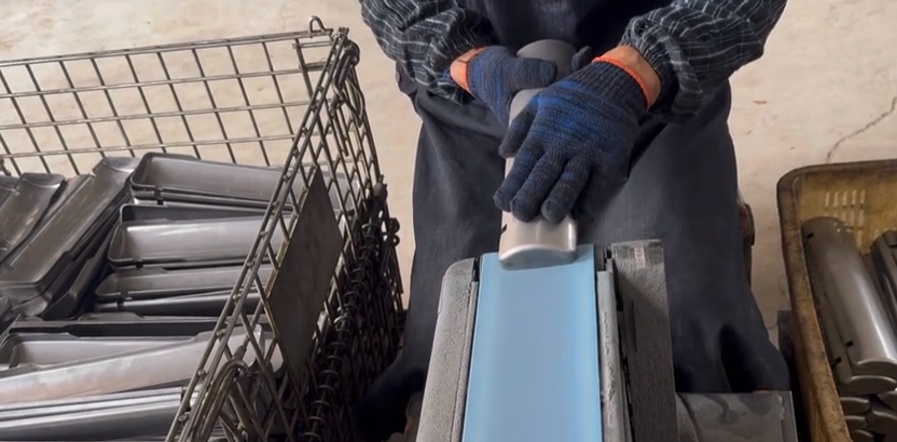Burrs are an unavoidable problem in the metal processing process. Whether it is drilling, turning, milling or plate cutting, the generation of burrs will affect the quality and safety of the product. Burrs are not only easy to cause cuts, but also affect subsequent processing and assembly, increasing production costs. In order to ensure the accuracy and surface quality of the finished product, deburring has become an indispensable secondary processing process, especially for precision parts. Deburring and edge finishing may account for more than 30% of the cost of the finished product. However, the deburring process is often difficult to automate, which brings difficulties to production efficiency and cost control.
Common deburring methods
Chemical deburring
Chemical deburring is to remove burrs by chemical reaction. By exposing the parts to a specific chemical solution, chemical ions will adhere to the surface of the parts to form a protective film to prevent corrosion, and the burrs will be removed by chemical reaction because they protrude from the surface. This method is widely used in the fields of pneumatics, hydraulics and engineering machinery, especially for deburring precision parts.
High temperature deburring
High temperature deburring is to mix the parts with hydrogen and oxygen mixed gas in a closed chamber, heat them to a high temperature and explode them to burn off the burrs. Since the high temperature generated by the explosion only acts on the burrs and does not damage the parts, this method is particularly suitable for parts with complex shapes.
Drum deburring
Drum deburring is a method of removing burrs by using abrasives and parts together. The parts and abrasives are placed in a closed drum. During the rotation of the drum, the abrasives and parts rub against each other, generating grinding force to remove burrs. Commonly used abrasives include quartz sand, wood chips, aluminum oxide, ceramics and metal rings. This method is suitable for large-scale production and has high processing efficiency.
Manual deburring
Manual deburring is the most traditional, time-consuming and labor-intensive method. Operators use tools such as steel files, sandpaper, and grinding heads to manually grind burrs. This method is suitable for small batches or parts with complex shapes, but it has low production efficiency and high labor costs, so it is gradually replaced by other more efficient methods.

Process Deburring
Process deburring removes sharp corners by rounding the edges of metal parts. Edge rounding not only removes sharpness or burrs, but also improves the surface coating of parts and enhances their corrosion resistance. Rounded edges are usually performed by rotary filing, which is suitable for parts that have been laser cut, stamped or machined.
Rotary filing: A solution for efficient deburring
Rotary filing is a very effective deburring tool, especially for edge processing of parts after laser cutting, stamping or machining. The rotary filing can not only remove burrs, but also make the edges smooth and rounded by rotating to quickly grind, reducing safety issues that may be caused by sharp edges. It is particularly suitable for processing parts with complex shapes or large quantities, helping to improve production efficiency and product quality.
Process Deburring
Process deburring removes sharp corners by rounding the edges of metal parts. Edge rounding not only removes sharpness or burrs, but also improves the surface coating of parts and enhances their corrosion resistance. Rounded edges are usually performed by rotary filing, which is suitable for parts that have been laser cut, stamped or machined.
Rotary filing: A solution for efficient deburring
Rotary filing is a very effective deburring tool, especially for edge processing of parts after laser cutting, stamping or machining. The rotary filing can not only remove burrs, but also make the edges smooth and rounded by rotating to quickly grind, reducing safety issues that may be caused by sharp edges. It is particularly suitable for processing parts with complex shapes or large quantities, helping to improve production efficiency and product quality.
Main Factors Affecting the Formation of End Milling Burrs
1. Milling parameters, milling temperature and cutting environment will have a certain impact on the formation of burrs. The influence of some major factors such as feed speed and milling depth is reflected by the plane cut-out angle theory and the tool tip exit sequence EOS theory.
2. The better the plasticity of the workpiece material, the easier it is to form type I burrs. In the process of end milling brittle materials, if the feed rate or plane cut-out angle is large, it is conducive to the formation of type III burrs (deficient).
3. When the angle between the terminal surface of the workpiece and the machined plane is greater than a right angle, the formation of burrs can be suppressed due to the enhanced support stiffness of the terminal surface.
4. The use of milling fluid is conducive to extending the tool life, reducing tool wear, lubricating the milling process, and thus reducing the size of burrs.
5. Tool wear has a great influence on the formation of burrs. When the tool is worn to a certain extent, the arc of the tool tip increases, not only the burr size in the tool exit direction increases, but also burrs in the tool cutting direction.
6. Other factors such as tool materials also have a certain influence on the formation of burrs. Under the same cutting conditions, diamond tools are more conducive to suppressing burr formation than other tools.
In fact, burrs are inevitable in the processing process, so it is best to solve the burr problem from a process perspective to avoid excessive manual intervention. Using a chamfering end mill can red
Post time: Nov-14-2024
